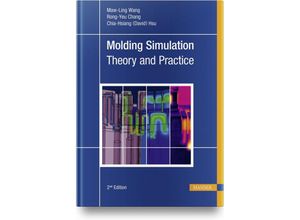This practical introductory guide to injection molding simulation is aimed at both practicing
engineers and students. It will help the reader to innovate and improve part design and molding
processes essential for efficient manufacturing. A user-friendly case-study-based approach is
applied enhanced by many illustrations in full color. The book is conceptually divided into
three parts: Chapters 1-5 introduce the fundamentals of injection molding focusing the factors
governing molding quality and how molding simulation methodology is developed. As they are
essential to molding quality the rheological thermodynamic thermal mechanical kinetic
properties of plastics are fully elaborated in this part as well as curing kinetics for
thermoset plastics. Chapters 6-11 introduce CAE verification of design a valuable tool for
both part and mold designers toward avoiding molding problems in the design stage and to solve
issues encountered in injection molding. This part covers design guidelines of part gating
runner and cooling channel systems. Temperature control in hot runner systems prediction and
control of warpage and fiber orientation are also discussed. Chapters 12-17 introduce research
and development in innovative molding illustrating how CAE is applied to advanced molding
techniques including co- bi-Injection molding gas- water-assisted injection molding foam
injection molding powder injection molding resin transfer molding and integrated circuit
packaging. The authors come from the creative simulation team at CoreTech System (Moldex3D)
winner of the PPS James L. White Innovation Award 2015. Several CAE case study exercises for
execution in the Moldex3D software are included to allow readers to practice what they have
learned and test their understanding. In the 2nd edition the concept of Cyber-Physical Systems
(CPS) in injection molding is introduced. In order to integrate molding simulation and
injection machines the workflow of machine response characterization is illustrated. By taking
into account the real-world machine response users can more accurately reflect the real-world
manufacturing conditions in simulations. The optimized processing conditions obtained from the
simulation can then be directly applied on the shop floor bridging the gap between simulation
and manufacturing. In addition a new flow-fiber coupling model i.e. the informed-isotropic
(IISO) viscosity developed by Dr. Favaloro and Prof. Pipes of Purdue University to simulate
the anisotropic flow for fiber-reinforced thermoplastics is introduced. The IISO coupling is
available to simulate some peculiar irregular filling patterns for fiber-reinforced melts at
high fiber concentrations: the free surface advances faster along the side cavity walls.



